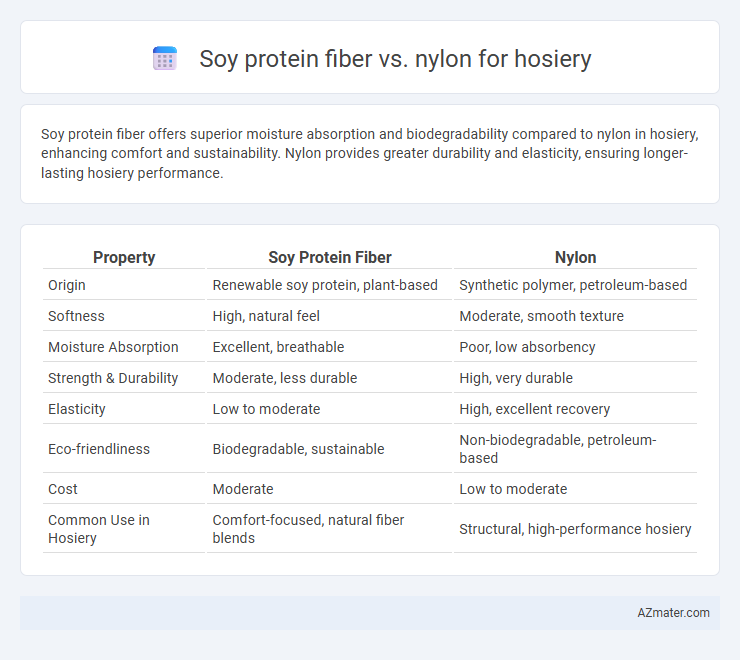Soy protein fiber offers superior moisture absorption and biodegradability compared to nylon in hosiery, enhancing comfort and sustainability. Nylon provides greater durability and elasticity, ensuring longer-lasting hosiery performance.
Table of Comparison
| Property | Soy Protein Fiber | Nylon |
|---|---|---|
| Origin | Renewable soy protein, plant-based | Synthetic polymer, petroleum-based |
| Softness | High, natural feel | Moderate, smooth texture |
| Moisture Absorption | Excellent, breathable | Poor, low absorbency |
| Strength & Durability | Moderate, less durable | High, very durable |
| Elasticity | Low to moderate | High, excellent recovery |
| Eco-friendliness | Biodegradable, sustainable | Non-biodegradable, petroleum-based |
| Cost | Moderate | Low to moderate |
| Common Use in Hosiery | Comfort-focused, natural fiber blends | Structural, high-performance hosiery |
Introduction to Hosiery Materials
Soy protein fiber offers a sustainable and biodegradable alternative to traditional nylon in hosiery fabrication, providing enhanced moisture absorption and softness. Nylon remains favored for its exceptional durability, elasticity, and resistance to abrasion, ensuring long-lasting wear and shape retention. Combining soy protein fiber with nylon can optimize comfort and performance, catering to consumer demands for eco-friendly yet resilient hosiery materials.
Overview of Soy Protein Fiber
Soy protein fiber is a sustainable, biodegradable material derived from soybean protein, offering excellent moisture absorption and breathability, making it ideal for hosiery. Its natural softness and elasticity provide a comfortable fit while reducing skin irritation compared to synthetic options like nylon. Though nylon excels in durability and stretch recovery, soy protein fiber's eco-friendly properties and skin-friendly attributes make it a popular choice in sustainable hosiery production.
Overview of Nylon in Hosiery
Nylon is a synthetic polymer widely used in hosiery due to its exceptional strength, elasticity, and durability, providing a smooth and glossy finish that enhances garment appearance. Its moisture-wicking properties and resistance to abrasion make nylon ideal for high-performance hosiery, ensuring comfort and longevity during wear. Compared to soy protein fiber, nylon offers higher tensile strength and better shape retention, making it a preferred choice in the hosiery industry.
Sustainability and Environmental Impact
Soy protein fiber for hosiery offers a renewable, biodegradable alternative to nylon, reducing reliance on petroleum-based materials and lowering carbon emissions during production. Nylon, while durable, contributes significantly to microplastic pollution and requires high energy consumption for manufacturing. Choosing soy protein fiber supports sustainable textile practices by promoting eco-friendly raw materials and minimizing environmental degradation.
Comfort and Skin Friendliness
Soy protein fiber in hosiery offers superior comfort and skin friendliness due to its natural, hypoallergenic properties and excellent moisture absorption, reducing irritation and enhancing breathability. Nylon, while durable and elastic, can trap heat and moisture, potentially causing skin discomfort or allergies for sensitive wearers. Choosing soy protein fiber hosiery supports a softer touch and better skin health, ideal for all-day wear.
Durability and Longevity
Soy protein fiber in hosiery offers excellent softness and moisture absorption but generally lacks the durability and longevity found in nylon fibers. Nylon provides superior strength, abrasion resistance, and elasticity, ensuring that hosiery made from nylon withstands repeated wear and washing without significant degradation. For consumers prioritizing long-lasting hosiery, nylon remains the preferred material due to its proven resilience and extended lifespan.
Moisture Management and Breathability
Soy protein fiber fibers exhibit superior moisture management by absorbing and releasing moisture rapidly, keeping hosiery dry and comfortable throughout wear. Nylon, while durable and strong, tends to retain moisture, which can reduce breathability and lead to discomfort over extended use. The natural composition of soy protein fiber enhances airflow and promotes breathability, making it an ideal choice for hosiery designed for active wear or warm climates.
Color Retention and Fabric Appearance
Soy protein fiber offers superior color retention for hosiery due to its natural ability to absorb and hold dyes, resulting in vibrant and long-lasting hues. Nylon, while durable and strong, tends to fade more quickly under repeated washing and exposure to sunlight, affecting the fabric's overall appearance. Hosiery made from soy protein fiber maintains a smoother, softer texture with less pilling, enhancing the garment's visual appeal over time compared to nylon.
Cost Comparison and Market Availability
Soy protein fiber hosiery generally costs more than nylon due to its sustainable production process and limited manufacturing scale. Nylon, widely available and mass-produced, offers a more affordable option for consumers seeking durable and stretchy hosiery. Market availability heavily favors nylon, making it the dominant choice in both retail and wholesale sectors worldwide.
Conclusion: Choosing the Right Fiber for Hosiery
Soy protein fiber offers exceptional softness, moisture-wicking properties, and biodegradability, making it an eco-friendly choice for hosiery. Nylon excels in durability, elasticity, and resistance to abrasion, ensuring long-lasting performance and shape retention. Selecting the right fiber depends on prioritizing sustainability and comfort with soy protein or durability and stretchability with nylon to match specific hosiery needs.

Infographic: Soy protein fiber vs Nylon for Hosiery
 azmater.com
azmater.com